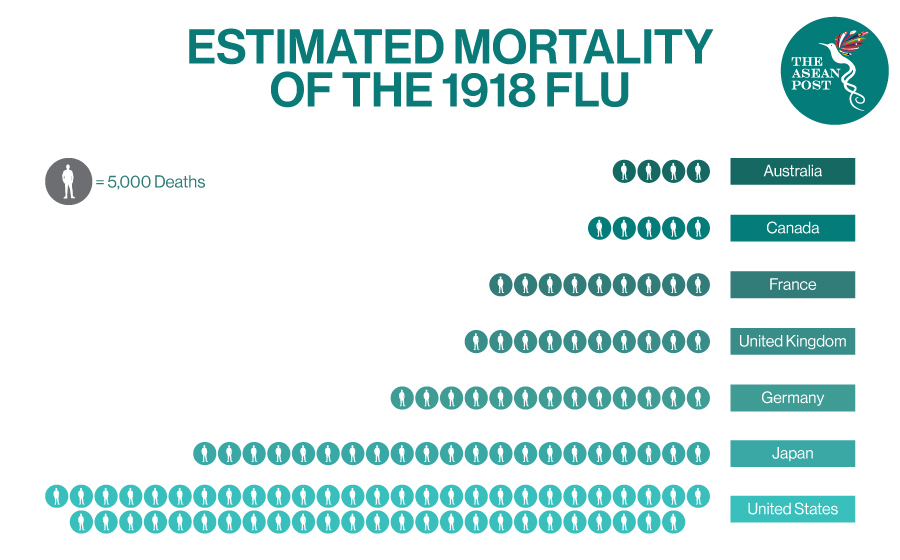Despite all the scientific and medical advances of the past 103 years, the COVID-19 pandemic has now killed more Americans than the 1918 flu pandemic did.
More than 675,000 people in the United States (US) have died from COVID-19, according to Johns Hopkins University. That surpasses the estimated US death toll from the deadliest pandemic of the 20th century.
"If you would have talked to me in 2019, I would have said I'd be surprised," said epidemiologist Stephen Kissler of the Harvard T. H. Chan School of Public Health.
"But if you talked to me in probably April or May 2020, I would say I would not be surprised we'd hit this point."
In April 2020, CNN published a list of lessons learned from the 1918 pandemic that could help mitigate the COVID-19 pandemic.
They included not ditching safety precautions too early; not getting a false sense of security among those young and healthy, and not relying on unproven treatments.
But Kissler said those lessons were not heeded by many.
"A lot of the mistakes that we definitely fell into in 1918, we hoped we wouldn't fall into in 2020," Kissler said. "We did."
Here's a look at some of the key differences and similarities between the 1918 pandemic flu and COVID-19:
What's Different Between The Two Pandemics
Population: The US population is now triple what it was in 1918. So while the COVID-19 death toll may be higher, the 1918 flu pandemic apparently killed a higher proportion of Americans, Kissler said.
Vaccine availability: Back in 1918, there was no pandemic flu vaccine, the US Centers for Disease Control and Prevention (CDC) said.
How Pandemic Flu Is Different From Seasonal Flu
Now, COVID-19 vaccines are available - but millions of eligible Americans have not been vaccinated.
In the United States, COVID-19 vaccines started rolling out to certain groups in mid-December 2020 - nine months after the World Health Organization (WHO) declared the coronavirus outbreak a pandemic.
By that time, more than 298,000 Americans had already died from COVID-19, according to Johns Hopkins data.
Fast forward to Monday (20 September 2021), and 36 percent of Americans ages 12 and older have not yet been fully vaccinated amid this Delta variant surge, according to CDC data.
Kissler said he believes the biggest disadvantage now compared to the 1918 pandemic actually involves a major technological advance.
"The internet can be a double-edged sword," he said. "It provides us with the opportunity to receive the CDC and the World Health Organization (updates) and to share information much more quickly. But that also means we can spread misinformation quickly as well."
For months, doctors have been trying to debunk popular myths shared on social media, saying they're actually jeopardizing public health and holding the country back.
What's Similar Between The Two Pandemics
Young people aren't invincible: Just because a person is young and healthy doesn't mean they can't be hit hard by a pandemic virus.
With the 1918 flu pandemic, "The high mortality in healthy people, including those in the 20- to 40-year age group, was a unique feature of this pandemic," the CDC said.
About two-thirds of the deaths from the 1918 pandemic were among people ages 18 to 50, said John Barry, author of the 2004 book "The Great Influenza: The Story of the Deadliest Pandemic in History."
"And the peak age for death was 28," Barry told CNN last year.

It might not be surprising that the pandemic flu spread rapidly among young adults in 1918. That was the final year of World War I, and many young soldiers were close together in barracks.
While there's no world war now, COVID-19 has proven young people can still be hit hard - even if their risk of death is much lower.
"We have absolutely seen - especially with long COVID - that young people are far from invincible," Kissler said.
Personal responsibility matters: No matter how good the science and public health advice are, "those things are only as good as the behavioral response," Kissler said.
During the 1918 flu pandemic, when cases had dropped in San Francisco, "the city fathers said, 'Let's open up the city. Let's have a great big parade downtown. We'll all take off our masks together,'" epidemiologist Dr Larry Brilliant said.
"Two months later, because of that event, the great influenza came back again roaring."
On the other side of the United States, Philadelphia suffered a similar fate.
Even though 600 sailors from the Philadelphia Navy Yard had the virus in September 1918, the city didn't cancel a parade scheduled for 28 September 1918.
Three days later, Philadelphia had 635 new cases of the flu, according to the University of Pennsylvania Archives & Records Center.
"Quickly, Philadelphia became the city with the highest influenza death toll in the US," Penn research states.
By contrast, St. Louis - which scheduled a similar parade but cancelled it - fared much better. The next month, more than 10,000 people in Philadelphia died from pandemic flu, while the death toll in St. Louis did not rise above 700, the CDC said.
Now, in mid-2021, almost every new COVID-19 death could have been prevented through vaccination, the CDC director said.
It's possible the viruses can spread long after the pandemic: The World Health Organization defines a pandemic as the "worldwide spread" of a new disease.
But there's no precise measurement for when a pandemic is over.
While the CDC said the 1918 pandemic happened in three waves, from the spring of 1918 to the summer of 1919, the virus kept circulating seasonally for 38 years.
Kissler said he believes SARS-CoV-2, the virus that causes COVID-19, might also stick around for years - even if the "pandemic" is over.
"We'll get new variants," including some that might cause reinfection, Kissler predicted. But eventually, "I do think those variants will be closely enough related, probably, to the things we've already been vaccinated against or the things we've already been exposed to that it won't cause the same sort of severe disease."
He stressed the best way to gain protection and help this pandemic sputter out is to get vaccinated - not wait for the exposure to the virus, which could lead to long COVID, hospitalization or death.
"Essentially, what the vaccine does is it gives you your first and second exposure for free" - without the dangers of COVID-19, Kissler said.
"That's extremely helpful, and that goes a long way to reducing mortality." - CNN
